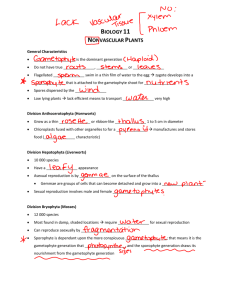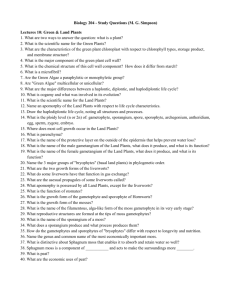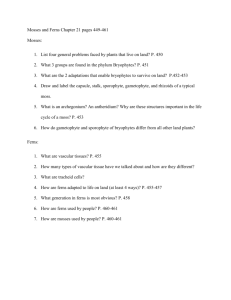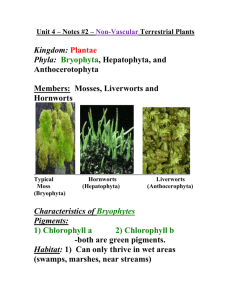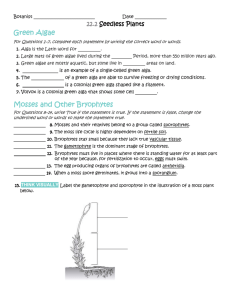File
advertisement
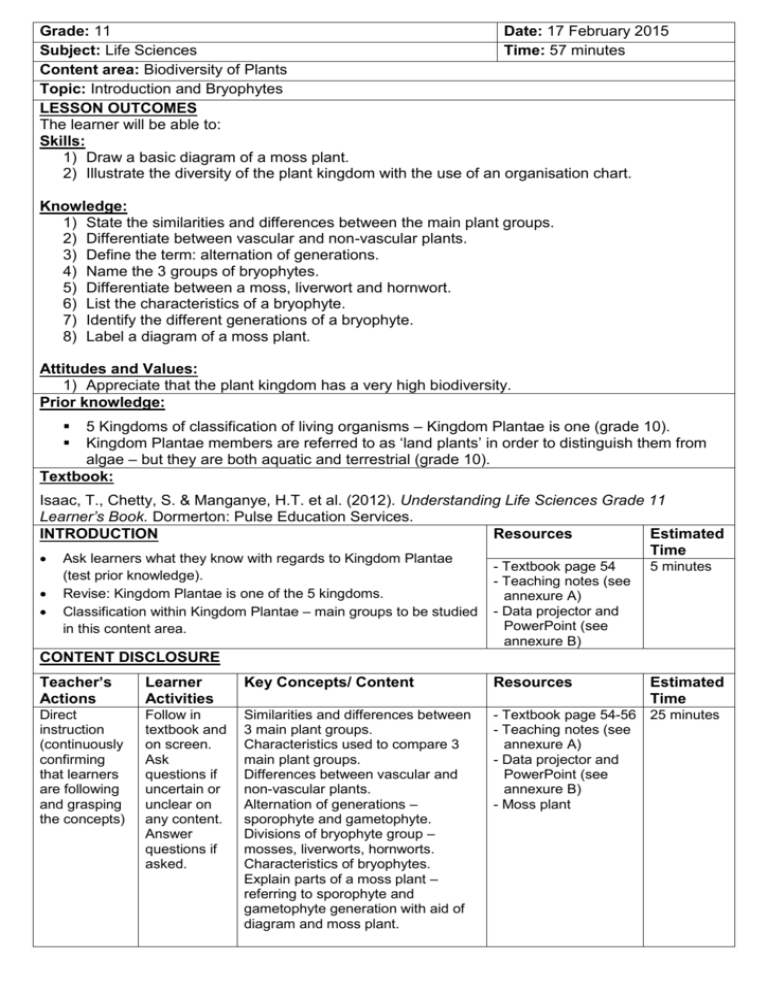
Date: 17 February 2015 Grade: 11 Time: 57 minutes Subject: Life Sciences Content area: Biodiversity of Plants Topic: Introduction and Bryophytes LESSON OUTCOMES The learner will be able to: Skills: 1) Draw a basic diagram of a moss plant. 2) Illustrate the diversity of the plant kingdom with the use of an organisation chart. Knowledge: 1) State the similarities and differences between the main plant groups. 2) Differentiate between vascular and non-vascular plants. 3) Define the term: alternation of generations. 4) Name the 3 groups of bryophytes. 5) Differentiate between a moss, liverwort and hornwort. 6) List the characteristics of a bryophyte. 7) Identify the different generations of a bryophyte. 8) Label a diagram of a moss plant. Attitudes and Values: 1) Appreciate that the plant kingdom has a very high biodiversity. Prior knowledge: 5 Kingdoms of classification of living organisms – Kingdom Plantae is one (grade 10). Kingdom Plantae members are referred to as ‘land plants’ in order to distinguish them from algae – but they are both aquatic and terrestrial (grade 10). Textbook: Isaac, T., Chetty, S. & Manganye, H.T. et al. (2012). Understanding Life Sciences Grade 11 Learner’s Book. Dormerton: Pulse Education Services. Resources Estimated INTRODUCTION Time Ask learners what they know with regards to Kingdom Plantae (test prior knowledge). Revise: Kingdom Plantae is one of the 5 kingdoms. Classification within Kingdom Plantae – main groups to be studied in this content area. - Textbook page 54 - Teaching notes (see annexure A) - Data projector and PowerPoint (see annexure B) 5 minutes Estimated Time CONTENT DISCLOSURE Teacher’s Actions Learner Activities Key Concepts/ Content Resources Direct instruction (continuously confirming that learners are following and grasping the concepts) Follow in textbook and on screen. Ask questions if uncertain or unclear on any content. Answer questions if asked. Similarities and differences between 3 main plant groups. Characteristics used to compare 3 main plant groups. Differences between vascular and non-vascular plants. Alternation of generations – sporophyte and gametophyte. Divisions of bryophyte group – mosses, liverworts, hornworts. Characteristics of bryophytes. Explain parts of a moss plant – referring to sporophyte and gametophyte generation with aid of diagram and moss plant. - Textbook page 54-56 25 minutes - Teaching notes (see annexure A) - Data projector and PowerPoint (see annexure B) - Moss plant Walk around classroom to ensure learners are working quietly and answer any questions learners may have. Learns to start summarizing page 54-56 in note book. CLOSURE: Recap important aspects with regards to: Kingdom Plantae – Bryophyta, Pteridophyta, Gymnosperms and Angiosperms. Differences between mosses, liverworts and hornworts. Characteristics of bryophytes. Differences between sporophyte and gametophyte generation in bryophytes. 20 minutes Resources Estimated Time - Textbook page 54-56 7 minutes - Teaching notes (see annexure A) - Moss plant HOMEWORK: Draw diagram of moss plant in note book (page 56 in textbook) ASSESSMENT: Activity 1.2.3. page 59 in textbook (to complete once Pteridophytes has been taught). Term Test 2 – 4 March 2015. REFLECTION: I think for my first time teaching at VP, this lesson went off well. I was extremely nervous but well prepared. My mentor teacher gave me lots of support with regards to helping me identify what content was important to teach and supplying me with a textbook. The lesson at first started off a bit shaky and it felt like I did not quite know where I was going with regards to the characteristics used to compare the 4 main plant groups, but I managed to recover when I moved onto the topic of the two plant generations and then once I reached bryophytes I felt a lot more confident. The class enjoyed the visuals within the power point and the physical moss plant that I brought into the classroom also made it easier for them to understand some characteristics of a bryophyte as well as visually being able to see the gametophyte generation on a moss plant. My mentor teacher said that I did very well, indicating that she was impressed with my first lesson. This gave me more confidence and has made me feel more comfortable for my future lessons that I will teach. I was also fortunate that this particular grade 11 class is very respectful when a lesson is being taught, respond and interact well when being asked any questions, and work well when they need to start work.


